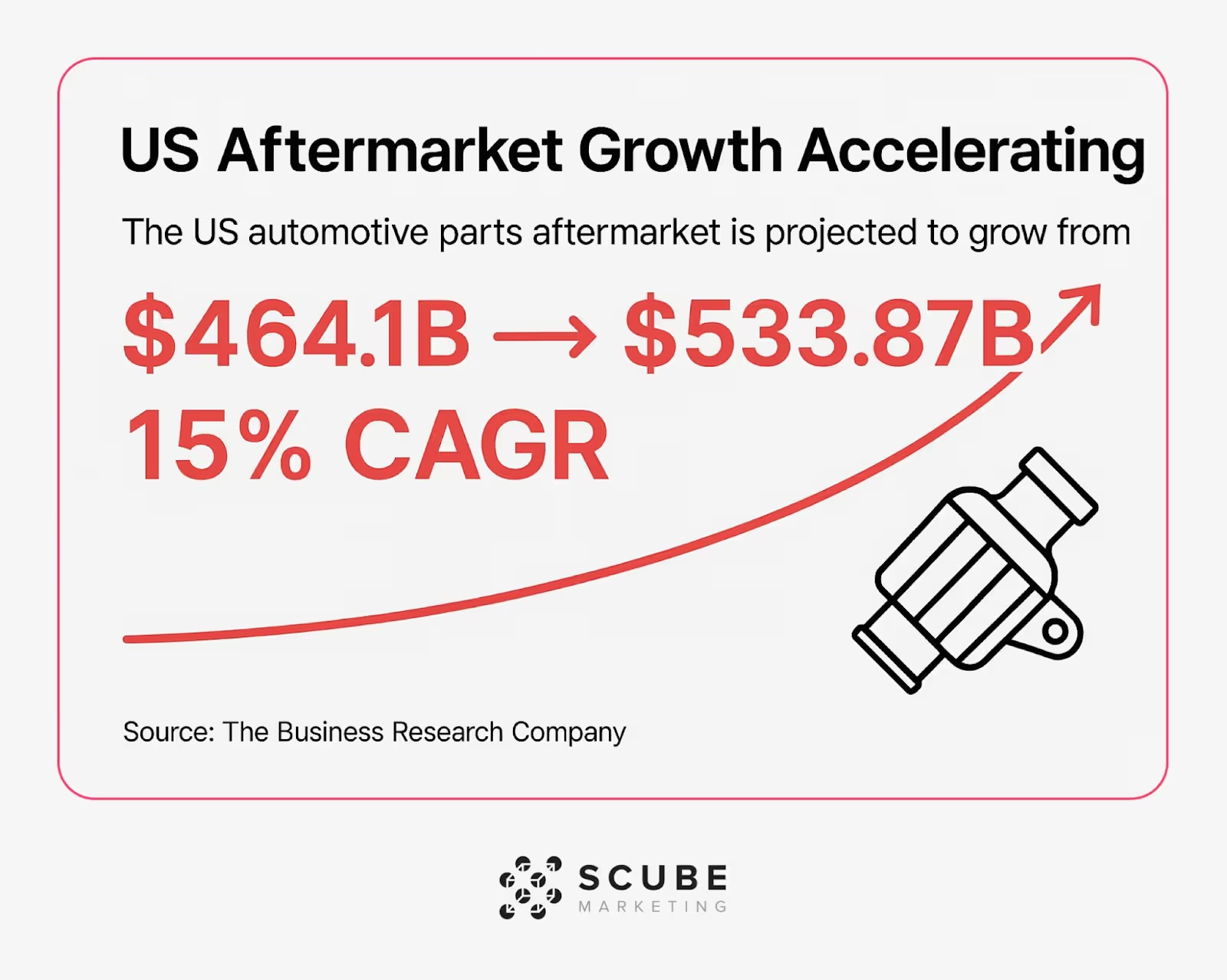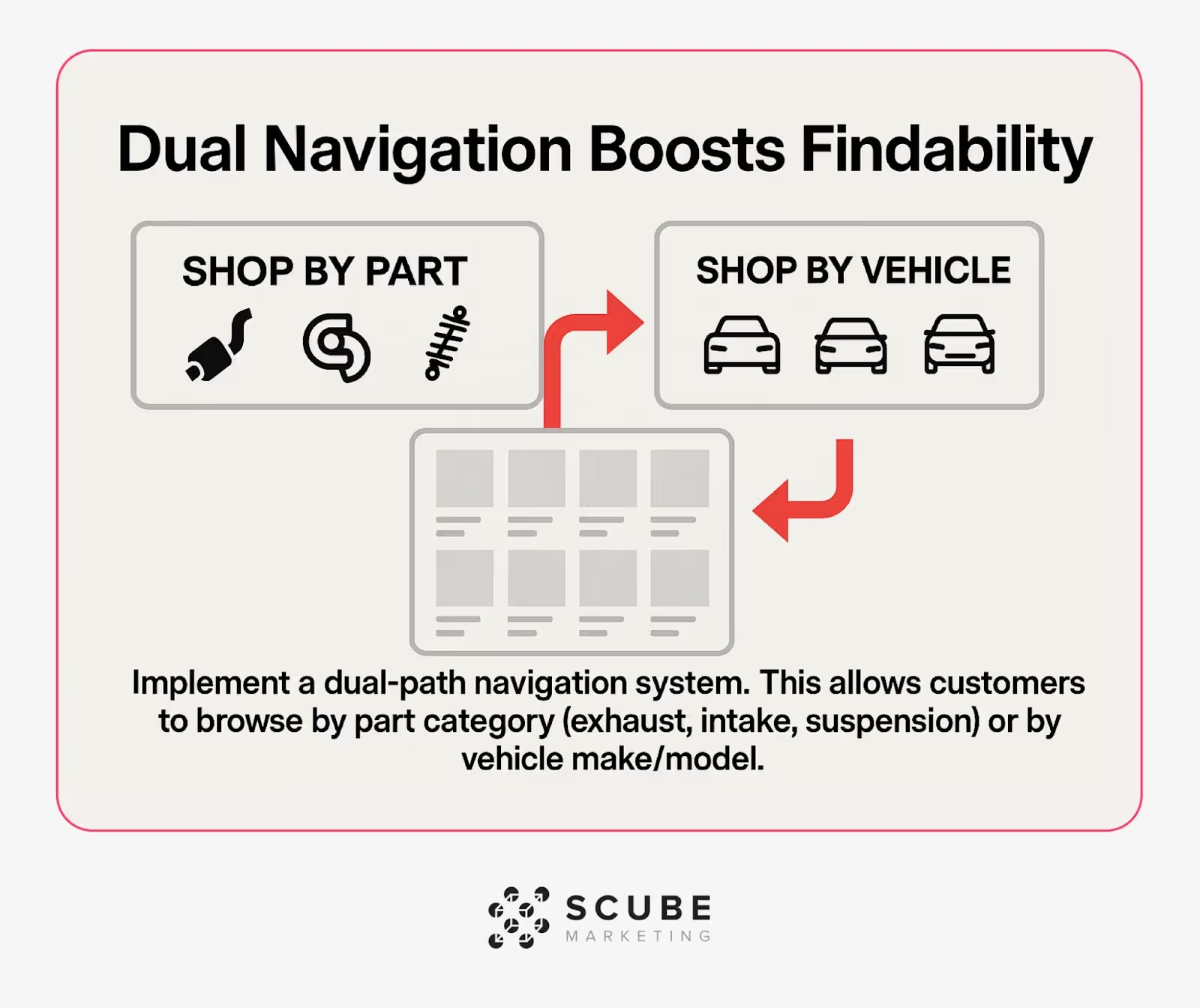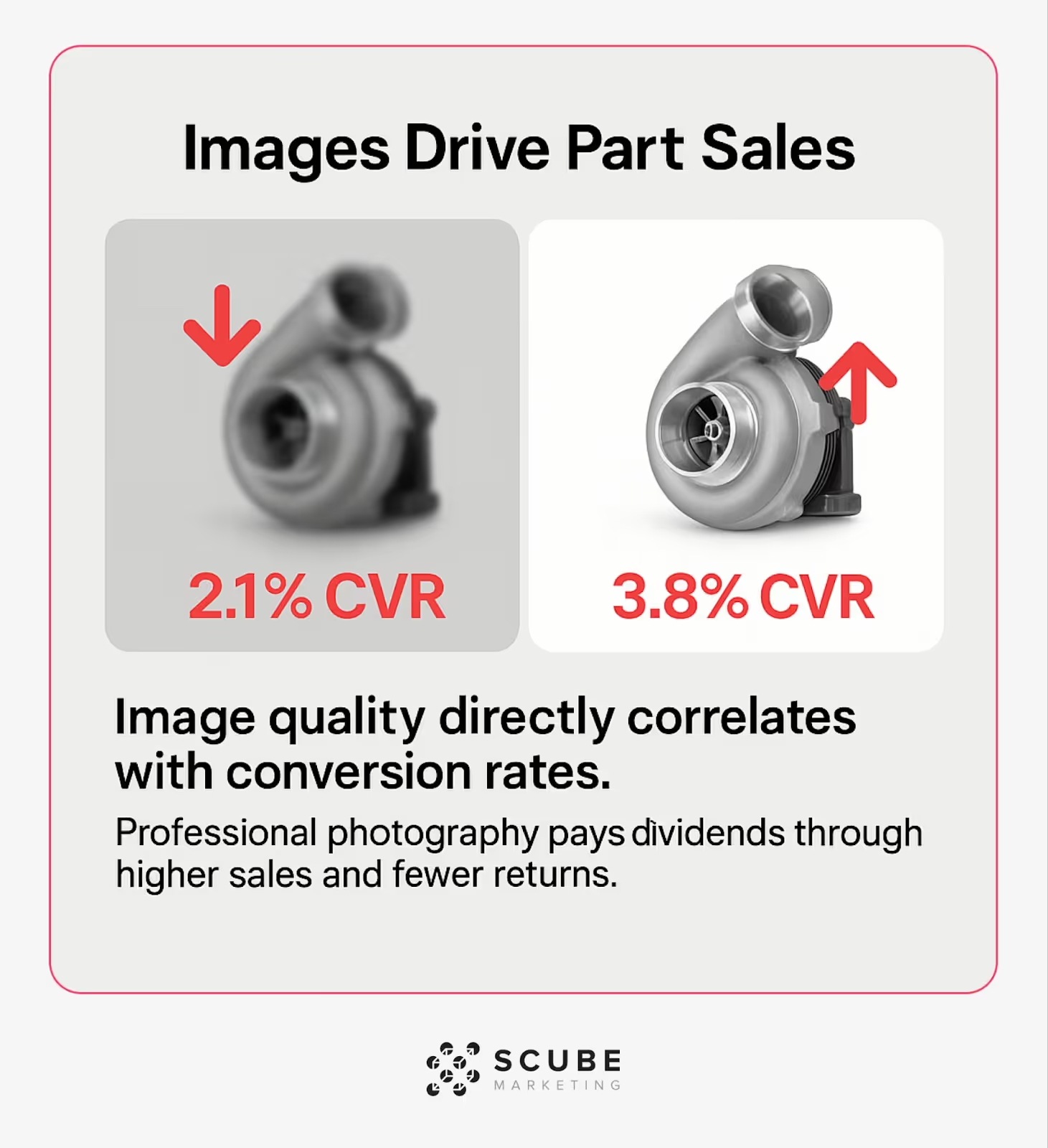
The aftermarket racing parts market is booming. Performance enthusiasts continually seek quality components to upgrade their vehicles. As an eCommerce marketing specialist working with automotive clients, I've seen both the tremendous opportunities and unique challenges this market presents.
What makes selling performance parts different from other eCommerce niches? It combines technical complexity with passionate customers who often have deep product knowledge. These shoppers research extensively and expect detailed information before making purchasing decisions.
This playbook offers proven marketing strategies specifically tailored for aftermarket racing and performance parts retailers. We'll cover everything from building your store foundation to driving qualified traffic and optimizing conversions.

The numbers tell a compelling story. The US automotive parts aftermarket is projected to grow from $464.1B in 2024 to $533.87B by 2025, representing a 15% CAGR. (Source: The Business Research Company)
Globally, the picture is equally impressive. The automotive aftermarket is currently valued at $499.4B in 2024 and is forecasted to reach $641.8B by 2030, growing at a 4.3% CAGR. (Source: Global News Wire)
.avif)
Within this broader market, mechanical products represent a significant segment. This category is expected to reach $256.7B by 2030, growing at a 3.8% CAGR. (Source: Global News Wire)
Let's break down these market statistics to understand what they mean for your marketing approach:
What drives these impressive numbers? Performance enthusiasts are passionate and willing to invest in quality components. The market includes everyone from weekend warriors upgrading street cars to serious racers building competition vehicles.
The aftermarket performance parts customer typically values technical knowledge, authenticity, and reliability. They often belong to vehicle-specific communities where reputation matters. Understanding these customer traits shapes every aspect of your marketing strategy.
Success begins with a solid foundation. Your eCommerce platform choice significantly impacts your marketing capabilities and customer experience. Performance parts retailers face unique challenges like complex fitment data and technical specifications.
Several key elements deserve special attention when setting up your store infrastructure. Vehicle compatibility, inventory management, and technical support capabilities all affect your marketing effectiveness. These foundational elements determine how well you can execute your marketing strategy.
I've worked with many aftermarket parts retailers who struggled with their platform choice. The right platform should support detailed product specifications, vehicle compatibility tools, and high-quality image galleries. These features aren't just nice-to-have—they're essential for converting knowledgeable automotive customers.
Platform selection impacts everything from SEO capabilities to checkout optimization. Performance parts retailers need specialized features beyond what general eCommerce platforms offer. Your choice affects how effectively you can market your products.
The most successful performance parts retailers prioritize these platform capabilities:
The foundation of your marketing success relies heavily on selecting the right inventory management software for your specific needs. Poor inventory management leads to overselling, underselling, and customer disappointment.
Effective catalog organization makes a tremendous difference in user experience. Performance parts require both category-based and vehicle-based organization systems. Your structure directly impacts both SEO and user navigation.

I recommend implementing a dual-path navigation system. This allows customers to browse by part category (exhaust, intake, suspension) or by vehicle make/model. Each approach serves different customer shopping behaviors and search patterns.
The most effective product organization approaches include:
Using standardized naming conventions across your catalog improves both searchability and SEO. Create consistent patterns for titles that include part type, vehicle compatibility, and key specifications. This helps both search engines and customers find exactly what they need.
Vehicle compatibility is perhaps the most critical element for performance parts marketing. Customers need absolute confidence that parts will fit their specific vehicles. Incomplete or inaccurate fitment data creates marketing challenges that no amount of promotion can overcome.
Implement a year-make-model lookup system with additional options for engine, transmission, and trim specifications. The more precise your compatibility data, the better your conversion rates will be. This detailed information also improves your organic search performance for specific vehicle searches.
Deeper Insights
Discover how to implement automotive email marketing strategies that drive repeat sales and build customer loyalty.
Product listings make or break sales. Performance enthusiasts scrutinize details before purchasing. They expect comprehensive information, clear imagery, and technical specifications. Your listings must satisfy both emotional appeal and technical requirements.
I've analyzed hundreds of performance parts listings across major retailers. The difference between high-converting and poor-performing listings is striking. Top performers combine technical depth with clear organization and visual appeal.
What elements create listings that actually convert? The formula combines several key components that work together to build buyer confidence and desire. Each element serves both informational and marketing purposes.
How can you effectively sell auto parts online? The answer starts with including these critical details in every product listing:
The way you present this information matters as much as the content itself. Format specifications in scannable tables or bullet points rather than dense paragraphs. This makes technical information easier to compare and digest.
Images sell performance parts. Quality photography from multiple angles is essential for parts that customers can't physically inspect before purchase. Your images should serve both practical and emotional purposes.
For maximum impact, include these image types for each performance part:

Image quality directly correlates with conversion rates. Professional photography is an investment that pays dividends through higher sales and fewer returns. Consider it part of your product marketing budget rather than an optional expense.
Performance parts buyers make decisions based on specific technical factors. They compare dimensions, materials, weight, tolerances, and performance metrics. Providing comprehensive specifications demonstrates product knowledge and builds credibility.
Include both technical specifications and real-world performance benefits. This combination addresses both analytical and emotional buying motivations. For example, don't just list "aircraft-grade aluminum construction"—explain how this reduces weight and improves heat dissipation.
Whenever possible, include performance testing results or comparative data. This might include dyno results for power-enhancing parts or weight savings for lightweight components. Verified performance metrics provide powerful selling points that justify premium pricing.
Smart product relationships boost average order values. Performance parts are rarely installed in isolation. Most modifications require or benefit from complementary components. Effective cross-selling recommendations increase both sales and customer satisfaction.
Implement these cross-selling approaches in your product listings:
The key is relevance. Generic "you might also like" recommendations underperform compared to specific "these parts work together" suggestions. Base your recommendations on actual installation requirements and common upgrade paths.
Traffic generation requires a multi-channel approach. Performance parts customers use diverse research methods including search engines, social media, forums, and video platforms. Your strategy must address each channel with appropriate content and messaging.
With the aftermarket auto parts industry showing significant growth, competition for visibility has intensified. Standing out requires both technical optimization and compelling content that resonates with enthusiasts.
Let's examine the most effective traffic sources for performance parts retailers. Each channel serves different purposes within your overall marketing strategy. The best approach combines these channels in a coordinated campaign.
Organic search drives substantial traffic for performance parts retailers. Enthusiasts frequently use specific search queries including part types, vehicle models, and performance goals. Effective SEO captures this intent and converts it to qualified traffic.
The most effective SEO approaches for performance parts include:
Focus on search terms that indicate purchase intent rather than general information queries. Terms like "best exhaust for 2022 Mustang GT" or "BMW M3 suspension upgrade parts" represent high-value search targets with clear commercial intent.
Paid search complements organic efforts by targeting competitive terms and specific products. Performance parts often have healthy margins that support profitable PPC campaigns. Strategic keyword selection and ad creation are essential for positive ROI.
Effective PPC strategies for performance parts focus on these areas:
Ad extensions significantly improve performance for parts retailers. Use price extensions for popular products, promotion extensions for sales, and structured snippets to highlight product categories. These enhancements increase click-through rates and pre-qualify traffic.
Social platforms provide both community engagement and advertising opportunities. Performance enthusiasts actively participate in model-specific groups and share their builds. These communities offer targeted marketing channels with built-in interest qualification.
Each platform serves different purposes in performance parts marketing:
Instagram excels for visual content showcasing installed parts and finished builds. The platform's visual nature makes it ideal for before/after comparisons and lifestyle content that highlights the emotional benefits of performance upgrades.
Facebook provides access to highly specific interest and vehicle ownership targeting. Its robust advertising platform allows for remarketing to website visitors and creating lookalike audiences based on your best customers. Groups offer organic engagement opportunities.
YouTube dominates for installation tutorials, product reviews, and performance demonstrations. Video content showing parts in action builds confidence and desire. Partner with influential builders and reviewers to extend your reach to established audiences.
Content marketing establishes authority and drives organic traffic. Performance enthusiasts consume vast amounts of content before making purchase decisions. Creating valuable resources positions your brand as an authority while capturing search traffic.
The most effective content types for performance parts marketing include:
Technical guides explain complex topics in accessible language. Cover subjects like "Understanding Suspension Geometry" or "How Forced Induction Affects Engine Performance." These educational resources attract researchers who often become customers.
Vehicle-specific upgrade guides provide step-by-step modification recommendations. Structure these as progressive paths from basic bolt-ons to advanced builds. This approach captures enthusiasts at various stages of their modification journey.
Installation tutorials remove purchase barriers by showing exactly what's involved in installing your products. Include both written guides with photos and video tutorials for maximum impact. Address common challenges and required tools.
Implementing effective eCommerce strategies for aftermarket parts can dramatically increase your conversion rates once you've attracted qualified traffic.
Conversion optimization is critical. Performance parts shoppers are typically comparing multiple options. They need compelling reasons to choose your store over competitors. Small conversion improvements yield significant revenue gains.
The performance parts purchase journey has unique characteristics. These buyers conduct extensive research, consult community opinions, and carefully evaluate technical details. Your conversion strategy must address these behaviors directly.
Let's explore the most effective conversion strategies for performance parts retailers. These approaches address specific friction points in the customer journey. They build confidence and reduce purchase hesitation.
Trust elements are essential for conversion. Performance enthusiasts worry about part quality, compatibility, and support. They need reassurance on multiple levels before committing to purchase. Your site must address these concerns proactively.
Implement these trust-building elements throughout your store:
Customer reviews carry exceptional weight in this market. Feature reviews that include vehicle details, installation experiences, and performance results. These specific testimonials resonate more effectively than generic star ratings.
Pricing strategy affects both conversion rates and profitability. Performance parts span wide price ranges with varying margin structures. Smart pricing approaches balance competitiveness with sustainable profitability.
Consider these pricing strategies for different product categories:
Transparency builds trust. Always show original prices when discounting and explain the value proposition clearly. Avoid hidden fees or surprise shipping costs that increase cart abandonment. Consider including free shipping thresholds to encourage larger orders.
Checkout optimization directly impacts conversion rates. Complex or lengthy checkout processes cause abandonment, especially on mobile devices. Simplifying this critical step can significantly improve your bottom line.
Optimize these checkout elements for maximum conversions:
Guest checkout options remove registration barriers while still capturing email addresses for marketing. Make account creation optional and highlight the benefits like order tracking and faster future purchases.
Mobile optimization is essential as more performance enthusiasts shop on smartphones. Ensure forms are easy to complete on small screens with large input fields, minimal typing requirements, and touch-friendly design.
Payment options should include credit cards, PayPal, and financing for larger purchases. Performance upgrades often represent significant investments. Offering financing increases conversion rates for high-ticket items by making them more accessible.
The purchase is just the beginning. Performance enthusiasts typically modify their vehicles progressively. Each purchase creates opportunities for follow-up marketing and additional sales. A strategic post-purchase sequence builds loyalty and lifetime value.
Implement these post-purchase marketing tactics:
Order confirmation emails should include related products and next logical upgrades. This immediate follow-up captures additional sales while purchase momentum remains high. Include both complementary and progressive upgrade options.
Installation follow-up emails sent 5-7 days after delivery provide support and feedback opportunities. Ask how the installation went and address any challenges. This demonstrates commitment to customer success beyond the sale.
Vehicle profile creation encourages customers to save their vehicle details for future shopping. This simplifies compatibility checking for subsequent purchases while providing valuable data for personalized marketing.
Measurement drives improvement. Performance parts marketing requires specific metrics beyond standard eCommerce tracking. The right data helps identify opportunities, optimize spending, and increase ROI. Analytics should inform every marketing decision.
Let's explore the most valuable metrics and testing approaches for aftermarket performance parts retailers. These measurement frameworks provide actionable insights for continuous improvement.
Certain metrics deserve special attention in this market. Beyond standard conversion rates and revenue figures, these specialized measurements provide deeper insights into performance parts marketing effectiveness:
Track these metrics alongside standard eCommerce measurements like conversion rate, average order value, and customer acquisition cost. The combination provides a comprehensive view of your marketing effectiveness.
Testing drives optimization. Systematic A/B testing identifies what actually works for your specific audience. Small improvements compound over time to create significant performance gains.
Prioritize these high-impact testing opportunities:
Use a structured testing approach rather than random experiments. Start with elements closest to the purchase decision and work backward through the funnel. Document all test results to build an optimization knowledge base over time.
Direct customer input provides invaluable insights. Performance enthusiasts often have strong opinions about their shopping experience. Structured feedback collection identifies both problems and opportunities that analytics might miss.
Implement these feedback collection methods:
Post-purchase surveys sent after delivery ask specific questions about the shopping experience. Keep these brief but include both rating scales and open-ended questions for qualitative insights.
Product review incentives encourage detailed feedback about specific products. Offer small discounts on future purchases in exchange for comprehensive reviews that include vehicle details and installation experiences.
Exit intent surveys capture feedback from non-converting visitors. Ask what prevented them from purchasing and what information was missing. This identifies conversion barriers that might not be obvious from analytics alone.
Competitive analysis provides context for your performance. Regular evaluation of competitor sites reveals industry trends, new features, and potential advantages. This ongoing research helps you stay ahead in a competitive market.
Focus your competitive analysis on these areas:
Product presentation comparisons reveal different approaches to technical information display, imagery, and pricing. Look for elements that could be adapted or improved for your store.
Special offers and promotions show competitive pricing strategies and incentive structures. Track these over time to identify patterns and seasonal approaches that drive competitor sales.
Content marketing initiatives demonstrate what topics and formats competitors prioritize. Analyze engagement signals to determine what resonates most with your shared audience.
Pattern recognition reveals success factors. Across the performance parts industry, certain approaches consistently outperform others. Understanding these patterns helps you implement proven strategies rather than reinventing the wheel.
Let's examine what actually works in this market based on observable patterns. These insights come from analyzing successful retailers rather than theoretical approaches.
Certain strategies appear consistently among top performers. These common elements represent proven approaches worth implementing in your own marketing:
Technical content marketing dominates successful strategies. Top performers create substantial resources explaining complex topics in accessible language. This content builds authority, drives organic traffic, and supports conversion.
Vehicle-specific organization appears universally among top retailers. Leading stores organize their entire shopping experience around specific vehicles rather than generic categories. This approach matches how enthusiasts actually think about their modification journey.
Community engagement extends beyond social media. Successful retailers actively participate in enthusiast forums, attend events, and sponsor builds. This authentic involvement builds credibility that pure advertising cannot match.
Visual emphasis pervades all marketing channels. High-performing stores invest heavily in professional photography, installation videos, and visual content. They recognize that performance parts are both technical and emotional purchases requiring strong visual support.
Certain mistakes repeatedly appear among struggling retailers. Avoiding these common pitfalls prevents wasted resources and missed opportunities:
The most damaging mistake is treating performance parts like commodity products. Enthusiasts value expertise, community reputation, and specialized knowledge. Price alone rarely drives their final purchase decisions.

Marketing aftermarket racing parts requires specialized approaches. The strategies outlined in this playbook address the unique characteristics of performance enthusiasts and their buying behavior. Implementation should be strategic and progressive.
Start by solidifying your foundation—ensure your product data, compatibility information, and technical content meet market expectations. Then build your traffic generation and conversion optimization efforts on this solid base.
Remember that performance enthusiasts value authenticity above all. They can instantly spot the difference between genuine knowledge and marketing fluff. Let your real expertise and passion for performance shine through in every marketing element.
I hope this playbook helps you build a marketing strategy as finely tuned as the performance parts you sell. Start implementing these approaches today, measure your results, and continuously refine your execution.